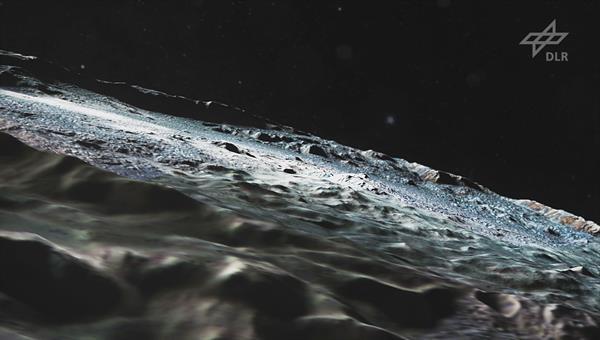Colossal crater on dwarf planet Ceres

Your consent to the storage of data ('cookies') is required for the playback of this video on Quickchannel.com. You can view and change your current data storage settings at any time under privacy.
NASA/JPL-Caltech/UCLA/MPS/DLR/IDA ESO/S. Brunier

The Occator crater on the dwarf planet Ceres is a real eye-catcher: with a diameter of 92 kilometres, it is larger than Tycho crater on the Moon – which appears like a bright spot when seen with the naked eye. The Occator crater's steep walls stand tall at over 2000 metres, higher than the North face of the Eiger in the Bernese Alps. And the bright spots in its interior have triggered a debate regarding their nature and origin among scientists around the world. "The impact that produced this crater probably created a connection to the lower strata – which might have caused a mixture of ice, mud and salt to rise to the surface through crevices in the crust," says DLR planetary researcher Ralf Jaumann, member of the camera team on the US-American Dawn mission. The light-coloured, calcareous salt on the surface of Ceres is a residue of this process. "It was like a kind of volcanic activity – but in this case it did not involve molten rock, but a liquid melted ice and mud mixture." A video produced by the German Aerospace Center (Deutsches Zentrum für Luft- und Raumfahrt; DLR) To the Institute's website simulates an overflight of this unique crater. The detailed results and other images will be presented at a press conference held on 15 December 2016 at the AGU (American Geophysical Union).
Flying over mysterious Occator
The video was produced using 548 images acquired by the German Framing camera on board the Dawn spacecraft, over 10,000 stereo combinations, and 106 million calculated points on the surface, with which the DLR planetary researchers prepared a three-dimensional elevation model of the dwarf planet. The resolution of 32 metres per pixel and a recording altitude of just 370 kilometres have therefore produced a flyover that allows observers to enjoy an ideal view of Occator's unusual topography and the light-coloured deposits in its interior. The bright, reflective regions have now been given their own names: the particularly eye-catching region at the heart of Occator with light spots and fissured bulge at its centre has been named 'Cerealia Facula', while the slightly less reflective patches to the east are called 'Vinalia Faculae'.
It should be noted that not all of the large craters on the dwarf planet Ceres exhibit these saline deposits that were clearly recognisable in Occator as the Dawn spacecraft approached the celestial body. "So it is possible that the impact at this particular site disturbed materials that are probably not present in other large craters," concludes Jaumann. On the surface, the melted ice immediately transitioned into the gaseous state, leaving mud and salts on the surface. This incident occurred around 18 million years ago – the recent past in a geological timeframe. Another theory suggests that the heat generated during impact caused the crustal material to melt, triggering hydrothermal alterations of the material and hence the formation of salts.
Extension for Dawn
This mission, which for the first time is observing and researching two celestial bodies from orbit – the asteroid Vesta and the dwarf planet Ceres – is in overtime: the mission was originally scheduled to end on 30 June 2016. But now, Dawn will now continue to explore the largest object in the Asteroid Belt between Mars and Jupiter possibly until the summer of 2019. "The fuel needed to adjust the orbiter's attitude might run dangerously low, but we do hope to stay close as the dwarf planet passes its perihelion over the course of its orbit around the Sun, where it may even become active," explains Jaumann. This extension, as well as the planned orbits around Ceres, are equally interesting for the camera team, amongst whom are several DLR planetary researchers. So far, the on-board camera has managed to image almost 2.8 million square kilometres of Ceres' surface. This is equivalent to the combined surfaces of France, Germany, Italy, Norway, Spain, Sweden and Great Britain. "But we are still missing a few small sections around Ceres' poles, which we hope to observe from a higher altitude during the mission’s extended lifetime." Dawn is currently circling the dwarf planet in an elliptical orbit, analysing it from a distance of 7000 to 9350 kilometres.
Dawn has been travelling in space for over nine years now: the mission was launched on 27 September 2007. It explored the asteroid Vesta from July 2011 until April 2012, before completing the two-and-a-half-year journey to dwarf planet Ceres, and entering its first observational orbit in March 2015. "It is a little too early to draw any conclusions – we are still in the thick of things," says Jaumann. "So far we have not understood how Ceres evolved." But one thing is certain: "Highly complex processes took place on Ceres – much more than simple collision and the resulting impact craters." The celestial body has been geologically active in the past – and this might still be the case with crustal alterations, outgassing and cryovolcanism.
The 2016 AGU press conference will be streamed online from 19:30 on 15 December 2016.
The mission
The Dawn mission is managed by NASA's Jet Propulsion Laboratory (JPL) in Pasadena, which is a division of the California Institute of Technology. The University of California, Los Angeles, is responsible for overall Dawn mission science. The Framing Camera system on the spacecraft was developed and built under the leadership of the Max Planck Institute for Solar System Research in Göttingen, Germany, in collaboration with the DLR Institute of Planetary Research in Berlin and the Institute of Computer and Communication Network Engineering in Braunschweig. The Framing Camera project is funded by the Max Planck Society, DLR, and NASA/JPL.
